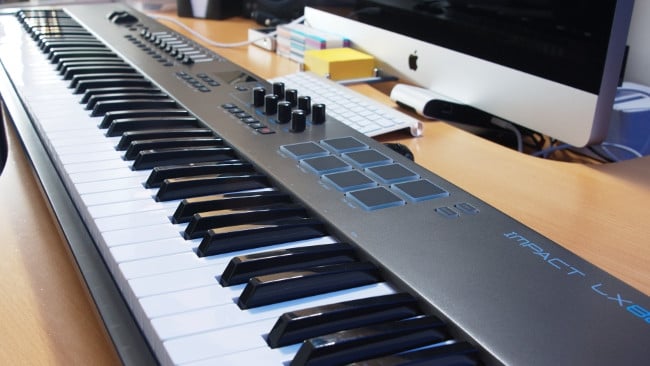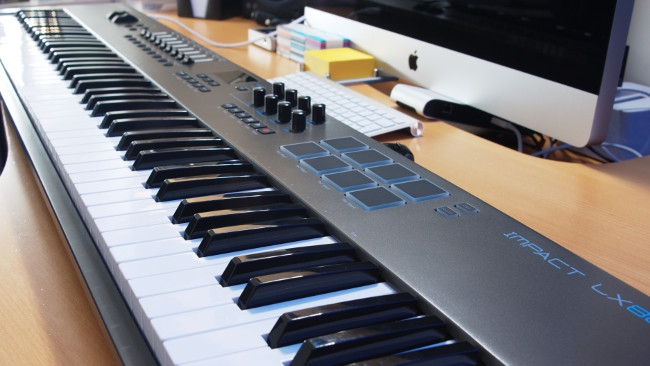
 The Impact LX88+ from Nektar
The Impact LX88+ from Nektar
We test drive the Nektar Impact LX88+ keyboard and MIDI controller, which represents a huge value for its price. By Erik Vlietinck.
Piano keys are quite heavy. That's because you are actually controlling a hammer that hits a steel cable under a lot of tension. Most cheap USB MIDI keyboards are spring-loaded and, therefore, light and relatively indifferent to your touch. Nektar's Impact LX88+ is an 88-key semi-weighted MIDI keyboard/controller. Its keys are part spring-loaded, part weighted. You instantly feel the difference.
The package
Nektar ships its Impact series of keyboards with a nice DAW: Bitwig 8-track. Bitwig Studio, the unlimited tracks version of Bitwig 8-track, running on macOS, Linux Ubuntu 12 and Windows 7/8/10. It supports the JACK API and ALSA (Advanced Linux Sound Association). I played with Bitwig 8-track for a couple of weeks and it has nice features that you would only expect from the likes of Logic Pro X and Reason. Bitwig 8-track users create a project and populate its tracks with 'clips', which you can then refine, arrange and trigger. Clips store either notes or audio, as well as control and automation data.
The integration of the LX88+ with Bitwig 8-track or Studio, Logic Pro X, Reason and others is very deep. There's almost no DAW feature that you can't control with the LX88+. With Logic Pro X, for example, you can use Logic's Learn feature to the full, making the assignment of controls to an instrument's controls a real breeze.
The secret to this easy integration is Nektar's integration script. The company offers integration scripts for 11 DAWs. These scripts are not written in stone. There's nothing stopping you from changing the pre-defined function mappings afterwards.
The Impact LX88+ has 88 semi-weighted velocity-sensitive keys, a bunch of control knobs, eight velocity-sensitive pads, six transport buttons, select controls (preset, mixer and instrument), an instrument page button, nine MIDI-assignable faders and LED illuminated buttons, five user configurable presets and a bunch of other controls. It has a 3-character LCD screen, weighs close to 8 kilos, is well-built and looks great with its colour-coded pads. It has a power socket for a 9V adapter, a jack socket to hook up a pedal and a MIDI out socket.
The keys require a heavier touch than spring-loaded keyboards, which is actually closer to a real piano feel and easier to control velocity. I calibrated the velocity curve of the LX88+ with Pianoteq's built-in calibration and this keyboard went all the way from 0 to 127.
Logically speaking
In Logic Pro X, the LX88+ controls almost everything. Mixer controls are arranged in banks, just like the pads. You can bank over between banks using a button combination. All pots, knobs and faders respond to the settings within the selected bank.
A unique feature is that you can control Logic Pro X's Smart Controls with the LX88+. The Impact series also support Logic's pickup mode. It does the same in Bitwig 8-track, but there it's called differently. Pads can be set to add markers, as well as be assigned to notes.
In short, Logic Pro X and the LX88+ are made for each other, but I can say the same of Bitwig 8-track. With Bitwig, the instrument button behaves a bit different from Logic in that the LX88+ controls the device in Bitwig, which can be an instrument, effect or container.
The Scenes button works as marker switch for the pads when using Logic. In Bitwig, it actually controls the Scenes and Clips feature. This means you can use the pads to play (and launch overdub, but I didn't try that feature) clips assigned to pads. You can also trigger scenes and play notes with pads.
The verdict
For the value it offers, the Impact LX88+ is dirt-cheap. Depending on your online store, it costs RRP£299.99, SSP£244.99.
Tags: Audio


Comments